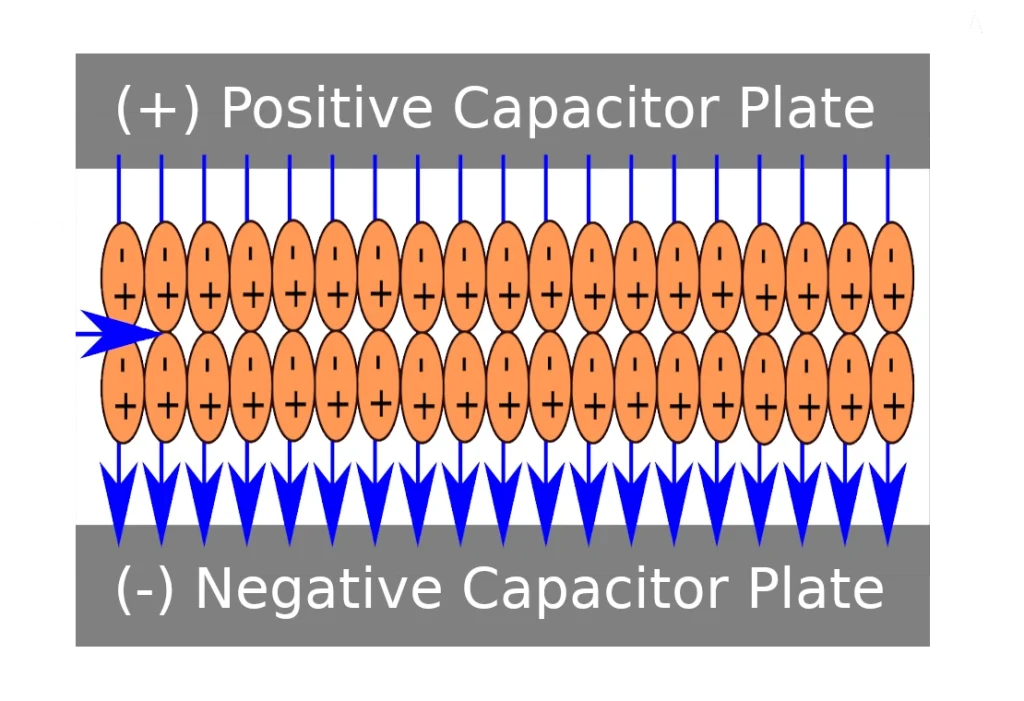Biefeld-Brown Effect
Let’s breakdown the Biefeld-Brown effect and analyze what the different contributing factors are to producing, and most importantly, maximizing the effect for real world propulsion.
There are many factors that together combine to create the Biefeld-Brown effect, the propulsive force observed in the direction from negatively to positively charged plate in a parallel plate capacitor. It is my hypothesis that the biggest factor behind the Biefeld-Brown effect is the production of spin alignment of unpaired protons in the dielectric and the metal capacitor plate electrodes.

Propulsion Factors Observed by Thomas Townsend Brown
- Capacitors charged to a high voltage move in the direction from negative to positive capacitor plate.
- There is a positive correlation between the voltage difference between the capacitor plates and the strength of the effect, where the higher the voltage, the greater the effect.
- There is a positive correlation between the dielectric strength (it’s ability to resist the flow of electricity through it) of the material between the electrodes and the strength of the effect, where the higher the dielectric strength, the greater the effect.
- There is a positive correlation between the dielectric constant (the ability of the dielectric to store electrical energy) of the material between the electrodes and the strength of the effect, where the higher dielectric constant, the greater the effect.
- There is a positive correlation between the area of the capacitor plates and the strength of the effect, where the greater the area of the capacitor, the greater the effect.
- There is a positive correlation between the mass of the dielectric material and the strength of the effect, where the greater the mass, the greater the effect.
- There is a negative correlation between the distance between the plates of the capacitor and the strength of the effect, where the effect increases linearly with the thinner the dielectric is.
Propulsion Factors From Biefeld-Brown Effect Experimenters
- There is a positive correlation with pulsed voltages versus static voltages where pulsed voltages have a greater effect than static ones and the higher the pulse rate the greater the effect.
Propulsion Factors Hypothesized by Me
- High voltages in a parallel plate capacitor creates electric dipoles in the atoms/molecules of the dielectric pulling the negatively charged electron clouds toward the positively charged plate and the positively charged nuclei toward the negatively charged plate.
- This causes the electric dipoles to have an axis of spin that is perpendicular to the plates.
- It is my hypothesis that the electric field of the capacitor polarizes the spin of the unpaired protons in the dielectric like rotating material with unpaired protons at high speed did under Wallace, Podkletnov, and Eskridge, with the propulsion direction from negative to positive plate.
- Atoms with unpaired protons whose spin are aligned cause other nearby atoms with unpaired protons to align their spin in the same direction as well as discovered by Wallace.
- With a sufficiently high electric field in the capacitor the dielectric and its atoms with unpaired protons will fully polarize.
- Furthermore, the polarized atoms with unpaired protons in the dielectric will influence the spin alignment of the capacitor plate electrodes nearby if they too are made of atoms that have an unpaired proton such as copper or aluminum.
- It is my hypothesis that the unpaired proton spin alignment of the dielectric spreads to the capacitor plates and will polarize these plates as well if the voltage of the capacitor is sufficiently high.
- It is my hypothesis that the there is a positive correlation between the mass of the capacitor electrode material and the strength of the effect, where the greater the mass, the greater the effect.
Historical Record of Relevant Experiments and Patents
Biefeld-Brown Effect Experiments
Experiments by Thomas Townsend Brown
- In 1929, Brown published an article called “How I Control Gravitation”. In it he mentions conducting an experiment using two 44lb lead spheres, separated by a 45 cm glass rod, and charged to 120kV DC with the capacitor moving in the direction of negative to positive lead sphere over the course of five seconds. With the static 120kV DC still applied it took between 30-80 seconds for the capacitor to return to its neutral position and then approximately five minutes with no electricity applied for the capacitor to be able to be used again as it needed to ‘rest’. With a capacitor weighing over 88lbs it would be fairly obvious if its movement was a result of ion wind, you would be looking at hurricane force winds. Brown discussed other experiments as well in the article, some in oil tanks to eliminate any ion wind and attained the same results of movement from negative to positive capacitor plate with static DC voltages applied.
Experiment by Robert Talley
- In 1991, Talley conducted experiments on a variety of extremely small capacitors that would fit inside a vacuum chamber. Talley used static and pulsed voltages of around 19kV in his experiments and dielectrics of acrylic and PZT.
- With the acrylic dielectric Talley measured no movement with a static DC voltage of 19kV applied. When using pulsed DC voltages of 19kV Talley recorded no movement with the exception of the highest pulse rate of 600Hz.
- With PZT Talley saw some interesting results. While a static DC voltage of 19kV was being applied to the PZT dielectric it appeared to be pulsing through the dielectric, as if the voltage was too high for the dielectric breakdown strength of the material. That said he detected movement during the pulses through the PZT.
- Talley requested additional experiments and funding from the Air Force but it never came.
Article by Takaaki Musha
- In 2000 and 2008, Musha published papers on the results of a Honda R&D Institute capacitor experiment from 1996. Honda used a single capacitor applying two different voltages to it in their experiment. One was a static DC voltage of 18kV, the other was a pulsed DC voltage of 8kV at 50Hz. The experiment showed more weight lost, more of a propulsive effect, with the pulsed voltage of 8kV than with the static voltage of 18kV even though the pulsed voltage was less than half the static one.
Experiment by George Matsoukas
- In 2012, Matsoukas published a paper on the results of his experiments with a lifter. Lifters are extremely light weight asymmetrical capacitors composed of balsawood, wire, aluminum foil, and air as their dielectric. Many do not realize the reason lifters don’t work in a vacuum is that the air that was their dielectric is gone and is replaced by vacuum which is an extremely poor dielectric for use in Biefeld-Brown effect experiments.
- Matsoukas found that by inserting a piece of lead sulfide in between the positive wire and negative aluminum foil electrode that the lifter lost a greater amount of weight indicating that the higher dielectric constant of the lead sulfide versus air increased the propulsive force of the lifter.
- Matsoukas used a voltage of 28kV and found pulsed voltages between 40-80Hz lowered the amount of power supplied by the power supply while keeping the lifter weight less.
Unpaired Particle Spin Alignment Experiments and Patents
Experiment by Samuel Barnett
- Paramagnetism and ferromagnetism are a result of unpaired electron spin alignment in paramagnetic and ferromagnetic materials and causes the force seen in for example, refrigerator magnets.
- The Barnett effect was discovered in 1915 by Samuel Barnett. It is a method of aligning the spin direction of unpaired electrons, in what was an iron bar, by rotating the iron bar at high speed, with the higher the speed the greater the magnetization. Barnett proved a method for polarizing unpaired particles, in this case electrons, by high speed rotation.
Patents by Henry William Wallace – GE Aerospace Engineer
- Wallace discovered and patented the generation of a force that he claimed was not electromagnetic in nature. Wallace used the method used in the Barnett effect, high speed rotation of a material, but in Wallace’s case it was a material with an unpaired proton in each copper atom rather than unpaired electrons.
- Wallace further discovered that the force was in a way analogous to magnetism in that materials with unpaired nucleons have a permeability to this non-electromagnetic force, like materials with unpaired electrons have a magnetic permeability.
- Wallace also discovered that unpaired spin aligned nucleons can induce nearby unpaired nucleons to align their spin in the same direction as well.
Experiments by Eugene Podkletnov – Materials Scientist
- In 1992, Podkletnov discovered that by rotating a YBCO superconducting disc at high speed the disc would lose some weight. YBCO contains atoms with unpaired nucleons.
- In 2020, Podkletnov discovered that by rotating a gold plated aluminum disc between 8,000-12,000 RPMs it would generate force capable of lifting hundreds of pounds and that it would create an attractive or repulsive field depending on the configuration of the disc which he did not elaborate on in an interview. Gold and aluminum atoms both have an unpaired proton. I emailed him asking for additional information and he stated with an ordinary rotating Gold/Aluminum disc a repulsive field was emitted from the top and bottom of the disc. Perhaps the field emitting from the bottom causes the propulsive effect but I believe the repulsive field emitted from the top is not a repulsive field at all. I believe the energized disc is shielding material above it from Earth’s gravity. Why? Henry William Wallace mentioned in his patents that materials with unpaired nucleons can shield external gravity fields like the Earth’s. Perhaps polarized parallel plate capacitors shield the material above it from Earth’s gravity field.
Experiment by R.H. Eskridge – NASA Scientist
- In 2021, Eskridge directed a research proposal and paper for NASA named “A Study of the Pope-Osborne Angular Momentum Synthesis Theory (POAMS) Including a Mathematical Reformulation and Validation Experiment”. In it they rotated a disc of Bismuth, which has an unpaired proton, and it lost and gained an identical amount of weight depending on being rotated clockwise or counterclockwise. His team proved there is a polarity to rotationally induced nucleon spin alignment opening the possibility for other methods of polarity induced nucleon spin alignment.
References
Barnett, S. (1915). The Barnett effect. https://en.wikipedia.org/wiki/Barnett_effect
Brown, T. T. (1929). How I Control Gravitation. Science and Invention, https://www.ttbrown.com/files/SciInv_Aug29.pdf
Eskridge, R.H. (2021). A Study of the Pope-Osborne Angular Momentum Synthesis Theory (POAMS) Including a Mathematical Reformulation and Validation Experiment. https://robertfrancisjr.com/pdfs/A Study of the Pope-Osborne Angular Momentum Synthesis Theory (POAMS) Including a Mathematical Reformulation and Validation Experiment.pdf
Ferromagnetism. https://en.wikipedia.org/wiki/Ferromagnetism
Musha, T. (2008). Explanation of Dynamical Biefeld-Brown Effect from the Standpoint of ZPF Field. https://robertfrancisjr.com/pdfs/Explanation of Dynamical Biefeld-Brown Effect from the Standpoint of ZPF Field.pdf
Paramagnetism. https://en.wikipedia.org/wiki/Paramagnetism
Podkletnov, E., Nieminen. R. (1992). A Possibility of Gravitational Force Shielding by Bulk YBa2Cu3O7−x Superconductor. Physica C, 441-444. https://robertfrancisjr.com/pdfs/A Possibility of Gravitational Force Shielding by Bulk Superconductor.pdf
Podkletnov, E. (2020). Eugene Podkletnov’s New Gravity Modification
Experiment & Video. https://robertfrancisjr.com/pdfs/Eugene Podkletnov’s New Gravity Modification Experiment & Video.pdf
Talley, R. L. (1991). Twenty First Century Propulsion Concept. https://robertfrancisjr.com/pdfs/Twenty First Century Propulsion Concept.pdf
Wallace, H. W. (1971). Method and Apparatus for Generating a Secondary Gravitational Force Field (US Patent No. US3626605). U.S. Patent and Trademark Office. https://robertfrancisjr.com/pdfs/Henry William Wallace – US3626605.pdf
Wallace, H. W. (1971). Method and Apparatus for Generating a Dynamic Force Field (US Patent No. US3626606). U.S. Patent and Trademark Office. https://robertfrancisjr.com/pdfs/Henry William Wallace – US3626606.pdf
